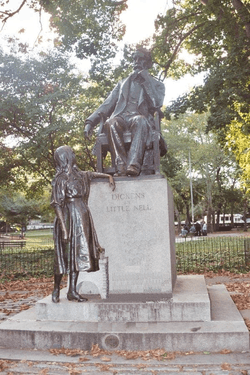Francis Edwin Elwell
Francis Edwin Elwell (also cited as Frank Edwin Elwell) (June 15, 1858 – January 23, 1922) was an American sculptor. From 1903 to 1905, he served as curator of ancient and modern sculpture at the Metropolitan Museum of Art in New York City.[1]


Life
Elwell was born in Concord, Massachusetts, on June 15, 1858. He was a great-grandson of Ephraim Farrar, a Minuteman who fought at Concord Bridge on April 19, 1775; a grandson of Elisha Farrar of Concord's literary circle; and the son of John Wesley and Clara Farrar Elwell.[2]
Elwell was orphaned at age four and, according to various sources, was adopted by author Louisa May Alcott[3] or grew up under the care of his grandfather, Mr. Farrar.[4]
Elwell received his first instruction in art from May Alcott’s sister, Abigail May Alcott, who also taught noted sculptor Daniel Chester French.[5] He studied at the Boston Museum of Fine Arts,[4] then moved in 1881 to Paris to study at the École des Beaux-Arts and later privately with Alexandre Falguière.[4] Elwell later studied under French and shared a studio with him in New York City.[5]
According to a 1922 biographical sketch, he was the first "to model a statue in America that was erected in Europe": Death of Strength, installed at Edam, North Holland.[2]
Elwell’s works are numerous and varied. He exhibited at the 1893 World’s Columbian Exposition in Chicago and the Salon de 1896 in Paris,[6] and later served as curator of ancient and modern sculpture at the Metropolitan Museum of Art in New York City. Elwell is further represented in the Senate’s Vice Presidential Bust Collection by a marble bust of Garret A. Hobart.[5]
Elwell lived for a time in Orange, New Jersey, and then for many years lived and sculpted at 12 Hudson Place in Weehawken, New Jersey, overlooking the Hudson River.[2]
In 1901, the government of Rhode Island made him an honorary colonel of the Seventh Rhode Island Infantry. For several years, he was a lecturer at Harvard University.[2]
In 1905, Elwell clashed with the Met's acting director, George H. Story. In response, the museum's trustees closed the sculpture department, fired Elwell, and had him escorted from the museum by a policeman.[7]
Elwell moved to Darien, Connecticut, in 1920. He died there on January 23, 1922, while waiting for a streetcar. The city flew its flags at half-mast.[2]
Works
- Death of Strength, (1888), on the tomb of Frederik Hendrik Pont at the cemetery around the Grote Kerk at Edam, North Holland
- Dickens and Little Nell (1890), Clark Park, bought by the Fairmount Park Art Association, Philadelphia, Pennsylvania. Received 1891 gold medal from Philadelphia Art Club, 1893 gold medal from World’s Columbian Exposition.
- Levi P. Morton (1891), marble bust in the U.S. Senate.[5]
- Diana and the Lion (1893), Art Institute of Chicago.
- Egypt Awaking, bought at the Paris Salon of 1896 by M. Gabriel Goupillat of Paris.
- Equestrian statue of General Winfield Scott Hancock (1896), on the battlefield of Gettysburg, Pennsylvania.
- New Life (1899), Lowell Cemetery, Lowell, Massachusetts, property of Hon. Charles Sumner Lilley, called the "Bonney Memorial." (plaster in Pennsylvania Academy of Fine Arts).
- Orchid (1899), owned by Theodore B. Starr, New York City.
- Pan-American Fountain (1901).
- Intelligence (1901), in front of New York state building for the Pan-American Exposition, Buffalo, New York.
- Elihu Yale (1901), Yale Club of New York City.[4]
- Colonel Robert Van Horn, (1906), marble bust, Van Horn High School, Independence, Missouri
- Seated Woman Monument (1916), Lowell Cemetery, Lowell, Massachusetts
- Seventh Rhode Island Infantry Memorial at the Vicksburg, Mississippi National Military Park.
- Bust of Mr. Peter Esselmont, Lord Provost of Aberdeen, Aberdeen, Scotland
- Memorial to Edwin Booth, Mount Auburn, Cambridge, Massachusetts.
- Aqua Viva, property of the Metropolitan Museum of Art, New York City.
- Andrew McMillan Memorial, Utica, New York.
- Kronos, “heroic-sized statue made for the Pan-american exposition in Buffalo, New York. 1901. Kronos (time) with veiled face, moves forward inevitably whether on swift wing or at the pace of a turtle. He holds in his hands all things that we know.” A smaller bronze cast of the original statue was presented to the Harvard Union in 1906 by Mrs. F. Edwin Elwell and now resides in the Barker Center on Harvard’s campus.
References
- Manuscripts: The Metropolitan Museum of Art Libraries
- A Notable Advisory Board (1922). American Biography: A New Cyclopedia. 12. New York City: The American Historical Society. pp. 259–261. Retrieved 1 June 2012.
- Elwell bio at AskArt.com
- Taft, Lorado (1969) [1903]. The History of American Sculpture. New York: Macmillan (reprinted by Ayer Company Publishing). p. 411. ISBN 0-405-02228-X.
elwell.
- Levi P. Morton bust in the U.S. Senate
- Who's Who (1967). Who Was Who, 1929-1940. A.C. Black. ISBN 9780713601701.
- "Museum's Trustees Oust Curator Elwell," NYT, October 17, 1905.
External links
| Wikimedia Commons has media related to Francis Edwin Elwell. |
- 1898 article about Elwell by Theodore Dreiser in The New York Times
- 1910 photo of Dickens and Little Nell at PhillyHistory.org
- Dickens and Little Nell at Philart.net
- Photos of Rhode Island infantry memorial in Vicksburg
- Francis Edwin Elwell Papers from The Metropolitan Museum of Art, including many letters to Elwell
- Article on the Frank Edwin Elwell Papers from The Metropolitan Museum of Art Libraries
- Frank Edwin Elwell papers from the Free Library of Philadelphia